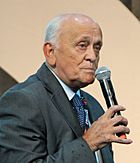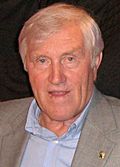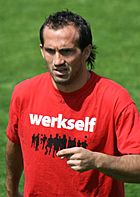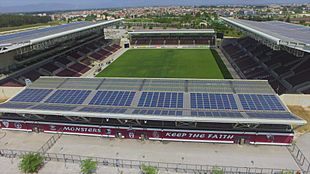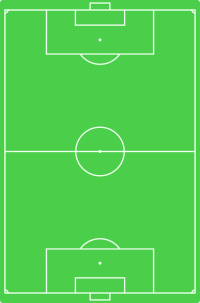Athlitiki Enosi Larissa F.C. facts for kids
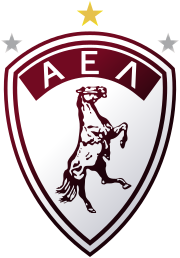 |
|||
| Full name |
|
||
|---|---|---|---|
| Nickname(s) | Βασίλισσα του Κάμπου (Queen of the Plains) Οι Βυσσινί (The Crimsons) |
||
| Short name | AEL | ||
| Founded | 17 May 1964 | ||
| Ground | AEL FC Arena | ||
| Capacity | 17,118 | ||
| Owner | Achilleas Ntavelis | ||
| President | Achilleas Ntavelis | ||
| Head coach | Giorgos Petrakis | ||
| League | Super League Greece | ||
| 2024–25 | Super League Greece 2, 1st (promoted) | ||
|
|
|||
Athlitiki Enosi Larissa F.C. (often called AEL or Larissa) is a professional football club from Larissa, Greece. The club was founded in 1964. It is known for its crimson and white colors. Their emblem is a rising horse, which is also a symbol of the city of Larissa.
AEL is one of the most important Greek football teams. It is considered the biggest team outside of the major cities of Athens and Thessaloniki. AEL is the only team from outside these big cities to have won the Greek Championship. This happened in the 1987–88 season. The club has also won the Greek Cup twice, in 1984–85 and 2006–07. They were also runners-up in the Cup finals in 1982 and 1984. This makes AEL one of the top 5 teams in Greek football history. The team has many passionate fans. They have strong rivalries with other big Greek teams like PAOK and Olympiacos.
AEL has also played in European competitions. They reached the group stage of the UEFA Cup in 2007-2008. They also made it to the quarter-finals of the UEFA Cup Winner's Cup in the 1984-1985 season. AEL plays its home games at AEL FC Arena. This stadium has seats for 17,118 fans. The team is currently competing in the top Greek league, the Super League Greece. They were promoted after winning their group in Super League 2.
Contents
Club History
AEL, known as the "Queen of Thessaly", represents one of Greece's greatest football regions. The club has won one championship and two cups. They have also reached four cup finals and achieved important successes in European games.
How AEL Started (1964–1979)
AEL was created on May 17, 1964. Four important local football clubs decided to join together. These clubs were Iraklis Larissa, Aris, Toxotis, and Larissaikos. The goal was to form a strong team that could represent Larissa in the top football league. The team's colors were chosen as crimson and white.
AEL played its first friendly game on June 7, 1964. They played against Panionios at Alcazar Stadium, their first home ground. AEL won 2–1. The team hired its first foreign coach, Alexander Petrovic from Yugoslavia. Many talented players joined the team.
The team aimed to reach the top league quickly. They finished fifth in their first season (1964–65). The next year, they improved to third place. In 1969, their position dropped. However, changes in Greek football rules helped AEL stay in the Second Division.
In the 1970s, the Kantonias family took over the club's management. They brought in experienced players. This helped the team improve a lot.
On June 25, 1972, AEL played a crucial game against Panserraikos. AEL needed to win to get promoted to the First National league. The game ended in a 1–1 draw. This result caused protests from AEL fans. They felt the team was treated unfairly.
First Promotion to the Top League
A year later, in 1973, AEL finally achieved its goal. They won the Second Division championship. On June 23, 1973, AEL beat Kallithea 3–0. This win secured their promotion to the First National league. Players like Horacio Morales and Daniel Hill from Argentina joined the team.
AEL started the 1973–74 season in the First National league with excitement. They finished in a strong 9th place. However, the team faced financial problems. They were relegated back to the Second Division in 1975.
The club then focused on developing local players from the Larissa area. Young talents like Takis Parafestas, Giannis Valaoras, and Dimitris Koukoulitsios joined the team. On June 18, 1978, AEL won a big game against Macedonikos (4–1). This victory made them champions of the Northern Group of the Second Division. AEL returned to the top Greek football league. This time, the team had a strong foundation for long-term success.
The Golden Decade (1980s)
The 1980s were a very successful time for AEL. The club continued to bring in talented young players. Coaches like Milan Ribar and Antonis Georgiadis helped the team grow. In 1979, Greek football became professional. AEL became AEL FC.
Sad Loss of Young Players
On September 6, 1979, Dimitris Koukoulitsios and Dimitris Mousiaris died in a car crash. They were on their way to train with the Greek Under-21 National team. Giannis Valaoras, who survived the accident, became one of the team's greatest players in the 80s.
"Small Hamburg": Cup Finalists and League Runners-up
AEL started to become a very strong team. They reached the Greek Cup final in 1982 for the first time. They lost 1–0 to Panathinaikos. The next season (1982–83), AEL finished second in the league. They were very close to winning the championship. The team played modern, fast football. They were nicknamed "Small Hamburg" after a famous German team.
More Cup Finals and European Success
In 1984, AEL reached another Cup Final. They lost again to Panathinaikos 2–0. However, they earned a spot in the UEFA Cup Winners' Cup. In the 1984–85 season, AEL had an amazing run in the Cup Winners' Cup. They reached the quarter-finals. They were knocked out by Dynamo Moscow. This showed how strong AEL was in European football.
1985 Greek Cup Winners
AEL was determined to win a title. On June 22, 1985, they played against PAOK in the Greek Cup final. AEL played incredibly well and won 4–1. This was the club's first major trophy! Key players like Michalis Ziogas, Kazimierz Kmiecik, and Giannis Valaoras scored goals. The team captain, Takis Parafestas, lifted the trophy.
The next year, AEL played against Sampdoria in Europe but lost. In October 1986, a sad event happened. A fan, Charalambos Blionas, died after being hit by a flare during a match. This was a very difficult time for Greek football.
The "Miracle of 1988": Greek Champions
In the 1987–88 season, AEL achieved something incredible. They won the Greek Championship. This was a huge surprise because AEL was the first and only team from outside Athens or Thessaloniki to win the title.
During this season, AEL faced a challenge. They had 4 points removed because of a "doping case" involving a player. The city of Larissa protested strongly. Roads were blocked for five days. Eventually, the rules were changed, and AEL's points were restored. This event brought the team and its fans even closer. In the second-to-last game, Giorgos Mitsibonas scored a famous goal against Iraklis. This goal secured the championship for AEL.
Difficult Years (1996–2003)
After their championship win, AEL faced harder times. The team struggled to keep its best players. Management changed often without clear plans. In May 1996, AEL was relegated to the Second Division after 18 years in the top league.
A very sad event happened on September 13, 1997. Giorgos Mitsibonas, a legendary player for AEL, died in a car accident. He was only 35 years old. His death was a big loss for the club and the city.
The club continued to face problems, including growing debts. In 2001, AEL fell to the Third Division for the first time. They were even at risk of falling further.
Almost to the Fourth Division
In the summer of 2002, AEL was at its lowest point. They had almost no money or proper management. The team even trained in a public park. They risked being relegated to the Fourth Division.
A local businessman, Nikos Sotiroulis, stepped in to help. He bought the club in 2003. A year later, the club was renamed AEL 1964 FC. They celebrated their return to the Second Division. On May 30, 2004, AEL won 5–1 against Pontiakos Nea Santa. This win secured their promotion. The fans were very excited, chanting "We are coming back!"
New Era (2004–2013): Piladakis Years
In 2004, Kostas Piladakis became the new owner and chairman. He brought in a new coach, Giorgos Donis, and many new players. AEL quickly returned to the Super League in 2005 after nine years. They finished first in the Second Division. The fans celebrated for days.
Back in the Elite: Cup Winners and European Games
In 2005, AEL signed Nikos Dabizas, a champion from UEFA Euro 2004. This showed that AEL wanted to be a top team. The fans traveled all over Greece to support the team. AEL finished 8th in the league. They got a chance to play in the UEFA Intertoto Cup. They played against Kayserispor from Turkey but did not qualify for the UEFA Cup.
The 2006–07 season was very successful. AEL won the Greek Cup again! This was their second Greek Cup title. On May 5, 2007, AEL beat Panathinaikos 2–1 in the final. The game was played in Volos, close to Larissa. Jozef Kožlej and Henry Antchouet scored the goals for AEL. Nikos Dabizas and Zissis Ziagkas lifted the trophy. This win confirmed AEL's return to the top of Greek football.
European Dream
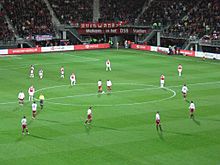
Winning the Cup meant AEL would play in the UEFA Cup in 2007–08. In the first round, they faced Blackburn Rovers from England. AEL won 2–0 at home and lost 2–1 away, qualifying for the group stage! In the group stage, AEL played against strong teams like Everton, AZ Alkmaar, Nürnberg, and Zenit Saint Petersburg. AEL did not get any points in the group, but they earned respect from top European coaches.
In the 2008–09 season, AEL had another great year. They went 13 games without losing. They finished fifth in the Super League. This earned them a spot in the UEFA Europa League for the third time in four years. They also broke long-standing traditions by winning against Iraklis in Thessaloniki and Olympiacos in Athens.
A New Difficult Period
After these successful years, AEL started to decline again. Poor decisions and players leaving led to problems. In 2009, they were knocked out of the Europa League by a weaker team. On November 16, 2009, Mexican striker Antonio de Nigris sadly passed away.
In 2010, AEL moved from their historic Alcazar Stadium to the new AEL FC Arena. However, the team struggled. They faced unfair referee decisions. Despite having star players, AEL was relegated to the Second Division in 2011. A match-fixing scandal was revealed in 2011, which showed that AEL had been treated unfairly.
Recent History
After being relegated, Kostas Piladakis tried to rebuild the team. He hired coach Chris Coleman and brought in international players. However, financial problems returned. Many players and the coach left. Piladakis resigned in 2013. The club was left without management and money. They were deliberately relegated to the Third Division to clear old debts.
In 2013, Evangelos Plexidas took over. The team was promoted from the Third Division easily. They also won the Greek 3rd Category Cup and the Amateurs' Super Cup. However, fans were unhappy with his management. In 2015, Alexis Kougias, a lawyer and football administrator, bought most of the club's shares.
On May 15, 2016, AEL was promoted back to the Super League. However, there was not much excitement among fans. Kougias had conflicts with the fans and local community. The team struggled in the top league but managed to avoid relegation. Since then, AEL has changed coaches many times. They continue to fight to stay in the top league and achieve success.
In July 2023, Achilleas Ntavelis became the new owner. He announced that the team would play its home games at AEL FC Arena again. The team was promoted to the Super League Greece for the 2024-25 season.
Honours
AEL has won several important titles:
Domestic Competitions
- Greek Championship
- Winners (1): 1987–88
- Runners-Up (1): 1982–83
- Greek Cup
- Winners (2): 1984–85, 2006–07
- Runners-Up (2): 1981–82, 1983–84
- Greek Super Cup
- Runners-Up (2): 1988, 2007
- Super League 2
- Winners (5): 1972–73, 1977–78, 2004–05, 2015–16, 2024–25
- Gamma Ethniki
- Winners (1): 2013–14
- Gamma Ethniki Cup
- Winners (1): 2013–14
- Amateurs' Super Cup
- Winners (1): 2013–14
International Competitions
- UEFA Cup Winners' Cup
- Quarter-finals (1): 1984–85
Crest and Colours
Crest Evolution
The club's emblem is a wild rising horse. This horse is believed to be an ancient Thessalian-breed horse. It is similar to Alexander the Great's horse, Bucephalus. The horse is also a symbol of the city of Larissa.
Colours and Kit Evolution
AEL's team colors have always been crimson and white. They have used these colors since the club was formed in 1964.
|
1964–65
|
1967–68
|
1987–88
|
1991–92
|
1995–96
|
2003–04
|
2008–09
|
2009–10
|
2010–11
|
2014–15
|
2018–19
|
Alternative Kits
|
1975–76
|
1978–79
|
1980–81
|
1994–95
|
1995–96
|
1996–97
|
2006–07
|
2009–10
|
2010–11
|
2016–17
|
2018–19
|
Facilities
Stadium
AEL FC Arena is where AEL plays its home games. It is a modern stadium with 17,118 seats. All seats are covered. The stadium can expand to hold 33,000 people. This makes it the third largest stadium in Greece. Besides football, the Arena also hosts conferences and music events. It took 14 months to build, from September 2009 to November 2010.
From May 2013 to September 2015, the team played at the old Alcazar Stadium. This was due to disagreements about stadium rent. On July 22, 2015, the club's owner promised the team would return to the Arena. They did, and played there for five years. In July 2020, new financial issues arose. AEL left the Arena again and returned to the renovated Alkazar. However, on July 26, 2023, the new owner announced that AEL would play at AEL FC Arena permanently.
Training Facilities
AEL has its own training facilities in the village of Dendra. These facilities cover over 30,000 square meters. They are used for many sports by all the team's athletes. The facilities include:
- Three football fields (one for the first team, one for the U21 team's official matches).
- One football field with artificial turf.
- Living areas for the first and reserve teams.
- A gym.
- Saunas.
- Rooms for planning tactics.
- A press room.
- Changing rooms.
- Offices.
- Parking areas.
Supporters
-
AEL fans in Kalamata during a game in February 2005
-
AEL fans in Veria during a game in January 2008
-
AEL fans in AFAS Stadion in a European game against AZ Alkmaar
Monsters is the biggest AEL FC supporters club. The first attempt to organize fans was on March 31, 1982. About 30 fans gathered at Gate D of the old Alcazar Stadium. This gate later became the famous Gate-1. The Monsters club was formed to provide strong and passionate support for the team.
AEL fans often use banners and flags with the club's name and symbols. They have followed the team everywhere in Greece and Europe since the beginning. The Monsters have a close relationship with the German team 1. FC Nürnberg's fan club, Ultras Nürnberg 1994. Fans from both clubs often show support for each other.
S.F. Alkazar is the second largest AEL supporters club.
Records
Here are some of AEL's club records:
- Most Appearances:
 Giannis Galitsios (399 games)
Giannis Galitsios (399 games) - Most Goals:
 Giannis Valaoras (73 goals)
Giannis Valaoras (73 goals) - Biggest Home Win: AEL 8–2 Kavala (1981–82)
- Biggest Away Win: Veria 2–5 AEL (1987–88)
- Most Wins in a Season: 18 (1982–83, 1987–88)
- Most Points in a Season: 50 (2008–09)
- Record Home Attendance: AEL 2–1 Panathinaikos (18,493 fans, Alcazar Stadium, December 27, 1987)
All records are for the Super League and former Alpha Ethniki championships.
Players
Historical Squads
Here are the lineups for AEL's most famous teams:
|
1988 Greek Championship most common starting lineup (4–4–2)
|
1985 Greek Cup Final starting lineup vs. PAOK (4–3–3)
|
2007 Greek Cup Final starting lineup vs. Panathinaikos (4–5–1)
|
Current Squad
|
|
Reserves Squad
- (Players from the youth team who have professional contracts)
|
Retired Numbers
- 24
 Kobe Bryant, Shooting guard (2020) – honored after his death
Kobe Bryant, Shooting guard (2020) – honored after his death - 29
 Mathías Acuña, Forward (2021-2022) – honored after his death
Mathías Acuña, Forward (2021-2022) – honored after his death
Youth Squad
|
|
Notable Former Players
European Competitions
AEL has played in several European football tournaments:
| Season | Competition | Round | Opponent | Home | Away | Aggregate |
|---|---|---|---|---|---|---|
| 1981–82 | Balkans Cup | 1st Round | 3–1 | 0–3 | 3–4 | |
| 1983–84 | UEFA Cup | 1st Round | 2–0 | 0–3 (a.e.t.) | 2–3 | |
| 1984–85 | UEFA Cup Winners' Cup | 1st Round | 2–0 | 1–1 | 3–1 | |
| 2nd Round | 2–1 | 1–0 | 3–1 | |||
| Quarterfinal | 0–0 | 0–1 | 0–1 | |||
| 1985–86 | 1st Round | 1–1 | 0–1 | 1–2 | ||
| 1988–89 | European Cup | 1st Round | 2–1 | 1–2 (0–3 p) | 3–3 | |
| 2006 | UEFA Intertoto Cup | 3rd Round | 0–0 | 0–2 | 0–2 | |
| 2007–08 | UEFA Cup | 1st Round | 2–0 | 1–2 | 3–2 | |
| Group Stage (Group A) |
– | 1–3 | 5th | |||
| 2–3 | – | |||||
| – | 0–1 | |||||
| 1–3 | – | |||||
| 2009–10 | UEFA Europa League | 2nd Qual. Round | 1–1 | 0–2 | 1–3 |
See also
 In Spanish: Athlitiki Enosi Larissas para niños
In Spanish: Athlitiki Enosi Larissas para niños




